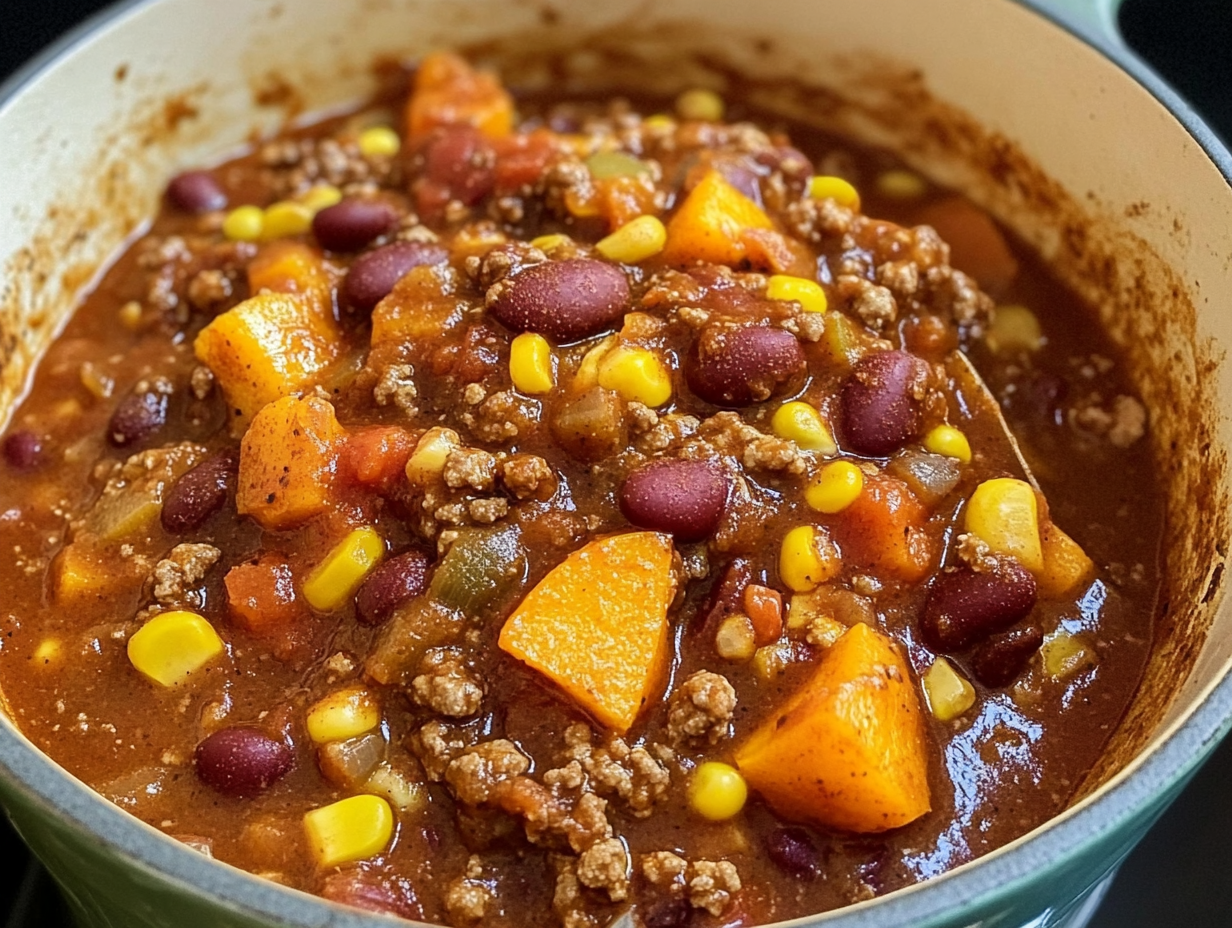Butternut Squash Chili is a hearty, comforting dish that combines the rich, savory flavors of traditional chili with the subtle sweetness and velvety texture of butternut squash. This vibrant orange vegetable adds a unique twist to the classic recipe, making it both visually appealing and deliciously satisfying. Whether you’re looking for a flavorful vegetarian option or simply want to incorporate more nutritious ingredients into your meals, butternut squash chili offers a wholesome, warming solution.
One of the standout features of butternut squash is its ability to enhance the depth of flavors in chili. Its natural sweetness balances the heat of spices like chili powder and cumin, while its soft, creamy texture complements the beans and tomatoes commonly found in chili. Beyond flavor, butternut squash is packed with nutritional benefits, making it a smart addition to any dish. It’s rich in vitamins A and C, which support immune health, and high in fiber, which promotes digestion and keeps you feeling full longer.
As plant-based diets gain popularity, vegetarian and vegan chili options like butternut squash chili are becoming more widespread. These alternatives are not only healthier but also environmentally friendly. In the sections that follow, we’ll dive into the key ingredients, preparation methods, and tips to make the best butternut squash chili.
Why Butternut Squash?
Butternut squash is a fantastic addition to chili because of its unique flavor and nutritional value. Its slightly sweet, nutty flavor balances the bold, spicy kick of traditional chili spices like cumin, chili powder, and paprika. This natural sweetness enhances the depth of the dish without overpowering the savory elements, making each bite more complex and satisfying.
In addition to its flavor, butternut squash offers numerous health benefits. It’s low in calories yet high in fiber, which aids digestion and promotes a feeling of fullness. The squash is also packed with antioxidants, including beta-carotene (which the body converts to vitamin A) and vitamin C, both of which boost immunity and support overall health. These nutrients make butternut squash chili not just delicious, but also a nourishing meal.
The texture of butternut squash is another reason it works so well in chili. Once cooked, it becomes tender and slightly creamy, which pairs perfectly with the firmness of beans and the heartiness of tomatoes. It can even serve as a plant-based substitute for meat, providing bulk and substance to the dish while keeping it vegetarian-friendly. Whether roasted, sautéed, or slow-cooked, butternut squash adds versatility and richness to chili.
Key Ingredients for Butternut Squash Chili
A well-balanced butternut squash chili relies on a combination of core ingredients that create a flavorful, hearty dish. Here’s a breakdown of the key components and how to prepare them.
Butternut Squash
The star ingredient, butternut squash, adds both texture and sweetness to the chili. When selecting squash, look for one that feels heavy for its size and has a smooth, tan skin. To prepare it, start by peeling the tough outer skin with a vegetable peeler. Then, slice the squash in half, scoop out the seeds, and cube it into bite-sized pieces. Roasting the cubed squash before adding it to the chili deepens its flavor and enhances its natural sweetness, though you can also sauté or slow-cook it directly in the chili.
Beans
For protein and texture, beans are essential in chili. Black beans, kidney beans, or a mix of both are popular choices. Black beans add a slightly earthy flavor, while kidney beans are meatier and hold up well during cooking. You can use canned beans for convenience, but if you’re using dried beans, be sure to soak and cook them beforehand.
Tomatoes
Tomatoes create the rich, savory base of the chili. Crushed tomatoes or diced tomatoes bring texture and acidity, while tomato paste adds depth and thickness. You can use fresh tomatoes for a brighter, lighter flavor or canned tomatoes for convenience and consistency.
Chili Spices
A blend of spices is what gives chili its signature flavor. Essential spices include chili powder, cumin, paprika, and garlic powder. These spices provide heat, smokiness, and depth to the dish. For extra kick, consider adding cayenne pepper or red pepper flakes.
Aromatics
Onions, garlic, and bell peppers form the aromatic base, contributing sweetness and depth. Sautéing these vegetables before adding them to the chili helps develop their flavors and adds richness.
Optional Ingredients
For extra texture and nutrition, you can add corn, quinoa, or mushrooms. Corn adds sweetness, quinoa provides protein and a slight crunch, and mushrooms bring an earthy, umami flavor.
Seasoning Balance
Balancing flavors is crucial in chili. Start with salt and pepper to taste, and adjust the heat by adding jalapeño peppers, cayenne, or hot sauce. Taste the chili as it simmers and tweak seasonings as needed to get the perfect flavor.
Fresh vs. Canned Ingredients
Using fresh ingredients like tomatoes and beans can provide a brighter, more natural flavor, while canned ingredients offer convenience and a richer, cooked-down taste. Choose based on your time and preference.
Step-by-Step Cooking Instructions for Butternut Squash Chili
1. Preparing the Butternut Squash
To begin, peel and cube the butternut squash into 1-inch pieces. You can prepare the squash in one of two ways:
- Roasting: Preheat the oven to 400°F (200°C). Toss the cubed squash with a bit of olive oil, salt, and pepper. Spread it out evenly on a baking sheet and roast for 20-25 minutes, turning halfway through, until the edges are golden and the squash is tender. Roasting brings out the natural sweetness and gives the chili a more caramelized flavor.
- Sautéing: Alternatively, you can sauté the squash directly in your pot. Heat a tablespoon of oil in a large pot over medium heat, and add the cubed squash. Sauté for 8-10 minutes, stirring occasionally, until the squash softens slightly. This method is quicker and works well when you don’t have time to roast.
2. Sautéing the Aromatics
Next, in the same pot (or a fresh one if you’ve roasted the squash), heat 1-2 tablespoons of olive oil over medium heat. Add diced onions, minced garlic, and chopped bell peppers. Sauté for 5-7 minutes, stirring occasionally, until the onions become translucent and the peppers soften. This step builds a flavorful base for the chili by releasing the natural sweetness of the aromatics.
3. Combining Ingredients
Once the aromatics are ready, add the following ingredients to the pot:
- Beans: Add 1-2 cans of black beans, kidney beans, or a combination of both. Be sure to drain and rinse them first if using canned beans.
- Tomatoes: Add 1 can of crushed tomatoes or diced tomatoes, and 1-2 tablespoons of tomato paste for depth. If using fresh tomatoes, you may want to add a little extra tomato paste to thicken the chili.
- Spices: Stir in chili powder, cumin, paprika, and garlic powder (1-2 teaspoons of each, depending on your taste). If you like extra heat, add cayenne pepper or diced jalapeños.
Mix everything together, ensuring the squash, beans, tomatoes, and spices are well combined.
4. Simmering for Optimal Flavor
Pour in 1-2 cups of vegetable broth to help the ingredients meld together and achieve the desired consistency. Bring the chili to a gentle simmer, then lower the heat and let it cook for 30-40 minutes, stirring occasionally. Simmering allows the flavors to develop and the butternut squash to soften further, creating a rich, flavorful chili. If the chili becomes too thick, add more broth or water. If it’s too thin, allow it to simmer uncovered for a while longer to thicken.
5. Optional Toppings for Serving
Once the chili is done, serve it hot with your choice of toppings:
- Avocado: Adds creaminess and balances the spices.
- Cilantro: Fresh herbs enhance the flavors.
- Vegan sour cream or regular cheese: For a tangy, creamy contrast.
6. Achieving the Perfect Consistency
To adjust the chili’s consistency, use:
- Broth or water: Add gradually to thin the chili.
- Tomato sauce or tomato paste: To thicken, stir in tomato paste or let the chili simmer uncovered to reduce excess liquid.
7. Using a Slow Cooker or Instant Pot
For convenience, you can make this chili in a slow cooker or Instant Pot:
- Slow Cooker: After sautéing the aromatics, transfer them, along with all other ingredients, to a slow cooker. Cook on low for 6-8 hours or on high for 3-4 hours.
- Instant Pot: Use the sauté function for the aromatics, then add the remaining ingredients. Seal the lid and cook on high pressure for 10 minutes, followed by a natural release.
Serving Suggestions for Butternut Squash Chili
Butternut squash chili is a versatile dish that pairs well with a variety of sides and garnishes, making it adaptable to different tastes and occasions. To create a heartier meal, serve the chili over a bed of grains such as rice, quinoa, or couscous. These grains absorb the flavors of the chili and add texture, making the meal more filling.
For added crunch, pair the chili with crusty bread, cornbread, or tortilla chips. Cornbread brings a slightly sweet contrast to the spiced chili, while tortilla chips add a satisfying crispy element. These sides are perfect for dipping or scooping up the chili.
Garnishing your chili enhances both the presentation and flavor. Consider adding fresh herbs like cilantro or parsley to brighten up the dish, or serve it with lime wedges for a refreshing citrus burst. For a creamy element, top with sour cream (or vegan sour cream) or shredded cheese to balance the spices.
When it comes to beverages, beer or cider pairs wonderfully with chili. Opt for a light, crisp beer or a slightly sweet cider to complement the richness of the chili. Alternatively, a light red wine, such as Pinot Noir or Zinfandel, adds a smooth, fruity note that contrasts the spices.
Recipe Variations for Butternut Squash Chili
Vegan Butternut Squash Chili
To ensure your butternut squash chili is entirely plant-based, simply use vegetable broth and avoid any animal-derived toppings like sour cream or cheese. For added protein, include extra beans or even lentils. Vegan toppings like avocado, cilantro, and vegan sour cream can add a creamy, tangy contrast to the dish. This version of the chili is not only hearty but also aligns with vegan dietary preferences, making it a nutritious and ethical choice.
Spicy Butternut Squash Chili
For those who enjoy extra heat, it’s easy to turn up the spice level. Add more chili powder or a dash of cayenne pepper to intensify the heat. For a fresh kick, chop up jalapeños or serrano peppers and add them to the sautéed aromatics. You can also drizzle in hot sauce or use chipotle peppers in adobo sauce for a smoky, spicy twist.
Meat-Lovers’ Variation
If you’re looking for a more traditional chili with meat, you can create a hybrid version by adding ground beef, turkey, or chicken. After sautéing the aromatics, brown the meat in the same pot before adding the rest of the ingredients. This variation combines the rich, savory taste of meat with the sweet and creamy flavors of the butternut squash, making for a hearty, protein-packed dish.
Smoky Chili
For a deeper, smoky flavor, use smoked paprika or chipotle peppers. Smoked paprika gives the chili a subtle smokiness, while chipotle peppers in adobo sauce bring both smoke and heat. This variation adds a rich, complex flavor that elevates the overall dish, making it especially satisfying during cooler months.
Sweet Potato Substitution
If you prefer a sweeter option, swap butternut squash for sweet potatoes. The method for preparing sweet potatoes is the same—peel, cube, and either roast or sauté them before adding them to the chili. Sweet potatoes bring an even sweeter flavor and a slightly creamier texture, offering a delicious twist on the classic recipe.
Chili Bar for Gatherings
For a fun, customizable experience, set up a chili bar at gatherings. Prepare a large pot of butternut squash chili and offer a variety of toppings like shredded cheese, sour cream, jalapeños, avocado, chopped onions, cilantro, lime wedges, and tortilla chips. This allows guests to personalize their bowls and enjoy the chili to their liking, making it a great option for casual parties or family dinners.
Health Benefits of Butternut Squash Chili
Butternut squash chili is not only flavorful but also packed with numerous health benefits, making it a nutritious choice for any meal. One of its standout features is its high fiber content, thanks to the butternut squash and beans. Fiber promotes digestive health, helps maintain regularity, and keeps you feeling fuller for longer, which aids in weight management.
The dish is also low in calories yet nutrient-dense, making it an excellent option for those looking to manage their weight without sacrificing flavor or nutrition. Butternut squash is rich in vitamins and antioxidants, particularly beta-carotene (which converts to vitamin A) and vitamin C, which promote eye health, boost the immune system, and reduce inflammation in the body.
Additionally, with the inclusion of beans, butternut squash chili is protein-packed, making it an ideal option for vegetarians and vegans. Beans provide plant-based protein and are also a great source of complex carbohydrates, which help sustain energy levels throughout the day.
The combination of beans and tomatoes offers significant heart health benefits. Beans are known to lower cholesterol and improve heart health, while tomatoes are rich in lycopene, a powerful antioxidant that helps protect the heart and reduce the risk of cardiovascular disease. Altogether, butternut squash chili is a well-rounded, heart-healthy meal that supports overall wellness.
Common Mistakes to Avoid
When making butternut squash chili, a few common mistakes can affect the final result. One major issue is overcooking the butternut squash, which can cause it to become mushy and lose its texture. To prevent this, cook the squash until just tender, or roast it before adding it to the chili for better control over its doneness.
Another mistake is under-seasoning. Butternut squash has a naturally sweet flavor, so it’s important to balance that with enough spices and seasoning. Make sure to taste as you go and adjust the salt, pepper, and chili spices to achieve a robust flavor.
Skipping the simmering process is also a common error. Simmering allows the flavors to meld together, resulting in a richer, more cohesive dish. Finally, avoid using too much liquid, as it can make the chili too watery. Adjust the liquid levels by adding broth gradually and allowing the chili to reduce until it reaches your desired consistency.
Frequently Asked Questions (FAQs) about Butternut Squash Chili
Can I use frozen butternut squash instead of fresh?
Yes, you can use frozen butternut squash as a convenient alternative to fresh. However, keep in mind that frozen squash has a higher moisture content and may cook faster than fresh squash. To avoid a mushy texture, add the frozen squash toward the end of cooking and adjust the cooking time accordingly.
How can I make this chili in a slow cooker or Instant Pot?
For a slow cooker, after sautéing the aromatics (onions, garlic, and peppers), transfer them along with the remaining ingredients to the slow cooker. Cook on low for 6-8 hours or on high for 3-4 hours. For an Instant Pot, use the sauté function for the aromatics, then add the remaining ingredients and cook on high pressure for 10 minutes, followed by a natural release.
Can I freeze butternut squash chili?
Yes, butternut squash chili freezes well. To freeze, let the chili cool completely, then transfer it to airtight containers or freezer-safe bags. It can be stored for up to 3 months. When reheating, thaw it overnight in the fridge and gently warm it on the stove, adding a little broth if needed to maintain the desired consistency.
How long does it last in the fridge?
Butternut squash chili can be stored in the refrigerator for up to 4-5 days. Store it in an airtight container to keep it fresh, and reheat it on the stovetop or in the microwave.
Is this chili gluten-free?
Yes, all the ingredients in this chili are naturally gluten-free. However, if you’re using pre-packaged ingredients like vegetable broth or canned beans, be sure to check the labels to ensure they are certified gluten-free.
Print
Butternut Squash Chili
Description
Here’s a structured recipe for Butternut Squash Chili based on your provided ingredients and instructions. The steps are numbered for ease of following.
Ingredients
- 1 teaspoon olive oil
- ½ cup chopped onions
- ½ cup chopped green peppers
- ½ cup chopped red peppers
- 2–3 garlic cloves, minced
- 1 pound ground beef
- 30 oz canned chili beans (drained, 2 cans of 15 oz each)
- 15 oz canned corn (or fresh/frozen corn)
- 15 oz canned diced tomatoes and chilis (drained)
- ½ cup broth (beef, chicken, or vegetable)
- 4 cups butternut squash (peeled, seeded, and chopped into ½ to 1-inch cubes)
- 6 oz canned tomato paste
Homemade Chili Seasoning:
- 1 tablespoon chili powder
- 1 teaspoon cinnamon
- 1 teaspoon cumin
- 1 teaspoon dried oregano
- 1 teaspoon red cayenne pepper (optional for extra heat)
- Salt and pepper to taste
Instructions
1️⃣ Sauté the vegetables:
Heat a Dutch oven or large stock pot over medium-high heat. Add the olive oil, chopped onions, green peppers, and red peppers. Sauté for a few minutes until the vegetables soften.
2️⃣ Add garlic and beef:
Stir in the minced garlic, and then add the ground beef. Use a meat chopper or spatula to break up the beef as it cooks. Season the beef with the homemade chili seasoning and cook for 5-6 minutes until fully browned. If needed, drain excess fat.
3️⃣ Add remaining ingredients:
Pour in the broth, beans, corn, diced tomatoes with chilis, tomato paste, and cubed butternut squash. Stir everything together to combine.
4️⃣ Simmer:
Reduce the heat to medium-low and cover the pot. Let the chili simmer for 35-40 minutes, stirring every 10 minutes, until the butternut squash becomes tender.
Note: If you are using pre-cooked roasted squash, reduce the simmer time to 15-20 minutes.
5️⃣ Cool and serve:
Once the chili has finished cooking, allow it to cool slightly before serving.
Notes
- For a spicier kick, don’t skip the cayenne pepper or consider adding extra chili powder.
- This chili can easily be made vegetarian by swapping the ground beef for plant-based crumbles or leaving it out altogether.





